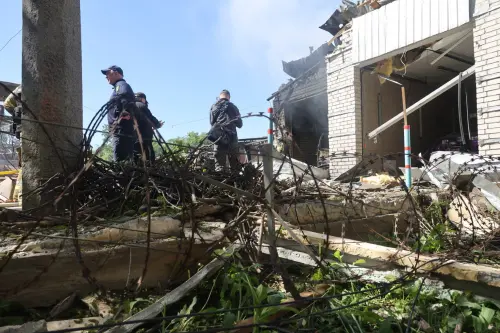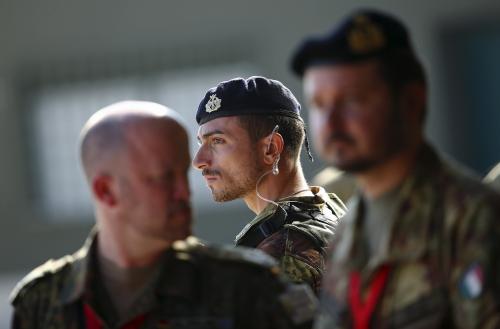Since 9/11, 3.3 million Americans have served in uniform. As of November 14, 2018, the Pentagon reports that 6,918 have died and 52,774 have been wounded in action, but as experts discussed at a recent event, this is just a fraction of those who are estimated to have been adversely impacted by the longest war in American history. On December 4, Michael O’Hanlon—senior fellow at the Brookings Institution—hosted a panel discussion with the Wounded Warrior Project (WWP) to roll out its survey on the physical, social, economic, and mental well-being of America’s veterans.
Wounded Warrior Project CEO Lt. Gen. Michael Linnington explained WWP’s mission: to transform the way America’s injured veterans are empowered, employed, and engaged in communities across the country. With the number of veterans reaching out to WWP on the rise, he argued that the information derived from its survey is important for determining the areas of greatest need and identifying trends. He offered a few sobering data points: The Pentagon’s own Defense and Veterans Brain Injury Center reports that more 380,000 have sustained traumatic brain injuries; in 2008, RAND estimated that “nearly 20 percent of military service members who have returned from Iraq and Afghanistan reported symptoms of post-traumatic stress disorder or major depression.”
The data
WWP’s Director of Metrics Melanie Mousseau detailed some key survey findings. Seventy-eight percent of those whom WWP serves say they’ve identified post-traumatic stress disorder (PTSD) as an injury they’ve incurred after their service, which isn’t an unusual trend according to Mousseau, but has been increasing slightly year over year. Mousseau also explained that the data shows U.S. troops aren’t as healthy as they should be—highlighting, in particular, high rates of obesity and lack of physical activity. And finally, she noted that WWP has used data from other surveys to organize programming related to education. While education hasn’t been a barrier to employment, Mousseau said, mental health issues have been.
O’Hanlon asked Mousseau how well the Department of Veterans Affairs (VA) has connected with the needs of veterans in a prompt way. She said that access to care continues to be a challenge, but the number of veterans using the VA’s services has been increasing year-over-year, while there has been a decrease in the challenges that veterans face when scheduling appointments. Mousseau also discussed the rate of veteran homeownership (which has been rising) and veteran unemployment (which though higher than the national average, has trended downward), arguing that mental health and other issues can be barriers to even higher veteran participation in the workforce.
Veterans’ relationships with the system
Tony Kurta, the deputy assistant secretary of defense for military personnel policy, discussed the relationship between the veterans and Kurta’s responsibility at the Pentagon to maintain a ready force for the country’s security today. He argued that the WWP survey provides important insights for the Department of Defense about what it can do better to transition service members from service into civilian life, better track how they’re faring and what issues they face, and figure out how the department should work with the VA and other agencies on the transition of veterans from uniform to civilian life.
Keita Franklin, national director of suicide prevention at the Department of Veterans Affairs, highlighted the alarming statistics that about 20 veterans a day end their lives by suicide, and that 6 of those 20 received healthcare in the VA system in the days and months before their death, while 14 did not. She observed that there is an increased rate among 18 to 34-year-olds committing suicide, arguing that it’s critical for the Departments of Defense and Veterans Affairs to collaborate. She also drew attention to data that show an increasing rate of suicides among female veterans—in fact, the female veteran suicide rate is 1.8 times higher than civilian women.
Franklin said that for her, some of the most relevant takeaways from the survey relate to how to best protect people from suicide—creating a life worth living, or things that give them hope in participating in a productive, meaningful life. One of these areas relates to employment, which she said can be a risk factor for suicide. Beyond employment for its own sake, a veteran who is gainfully employed feels that they have a mission and a sense of value that can parallel their time in the military.
How can the VA system, or organizations like WWP, help guide veterans through complex bureaucratic processes? Franklin stressed that improving veterans’ access to health care, while important and improving, isn’t enough. Many more issues have to be addressed, she argued, especially social aspects, connecting veterans to veteran service organizations, and improving access to employment. Franklin noted that a Trump administration executive order improves access to mental health care, particularly during the first 12 months after leaving active duty. Mousseau added that both data and qualitative, anecdotal feedback from veterans is important.
Kurta pointed out that the U.S. all-volunteer force comprises less than 1 percent of the American population, and there is a sense that many in the civilian world don’t understand fully the challenges faced by those who serve in uniform. One data point he highlighted was the importance respondents placed on being able to discuss their challenges with peers who have gone through a similar transition from uniformed to civilian life.
Connecting veterans and civilians
What can average civilians do to support veterans, especially those currently transitioning out of uniformed life?
Mousseau advocated increasing familiarity with the kinds of experiences that veterans are undergoing. Kurta observed that there are men and women in uniform, and veterans, in virtually every community in the United States, arguing that it is vital for civilians to find ways to interact with them and serve their needs. Finally, Franklin highlighted a program inside the VA and Department of Defense called “Be There,” which seeks to rally Americans around veterans’ issues in small ways, such as through socializing or providing transportation.
During the Q&A session, Franklin observed that the VA has worked to proactively reach out in the final 12 months of a service member’s active duty and in the first year (and beyond) afterwards to ensure their needs are best being met. On the question of socializing, Kurta observed that there are generational differences in the way veterans interact with each other, and it’s essential to be mindful of that. Asked whether there should be a greater focus on overall career trends—rather than just finding a job–Kurta replied that having a job is key to an individual’s resilience, hence the focus on it. He added: “We’ve now started to talk more about the socially protective factors, a sense of belonging. You lose some of that sense of mission, the esprit de corps, the camaraderie that you have from the uniform way of life.” So equipping veterans with education through the GI Bill and other mechanisms can help provide veterans with tools to build a career beyond the term of their first job out of uniform.







Commentary
What does survey data about service members and veterans tell us? Experts discuss
December 11, 2018